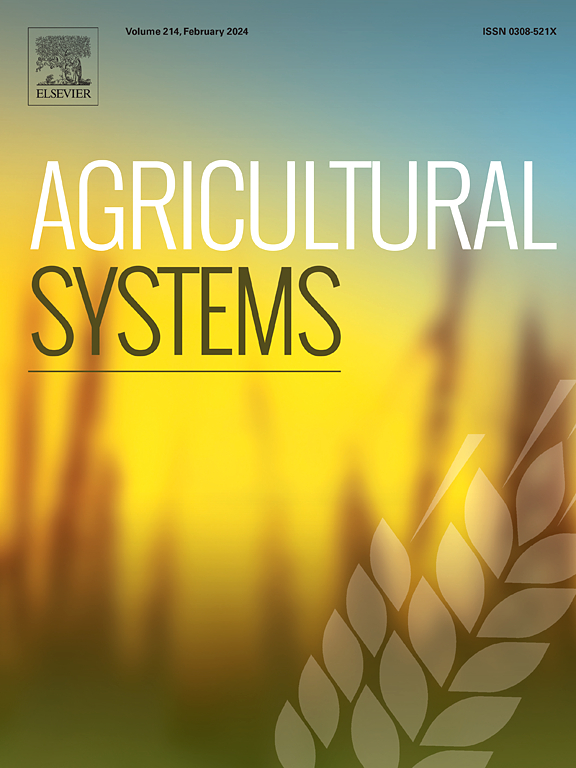表征埃塞俄比亚旱作小麦生产环境的特定作物和时变空间框架
IF 6.1
1区 农林科学
Q1 AGRICULTURE, MULTIDISCIPLINARY
引用次数: 0
摘要
描述作物生产环境对于有针对性的干预措施、资源分配、扩大局部发现和农业决策至关重要。然而,现有方法缺乏捕捉作物生产环境时空变化所需的空间和时间严谨性。本研究旨在引入一个数据驱动的动态空间框架,该框架将作物面积测绘与农业生态空间单元(ASUs)的描述相结合,以表征埃塞俄比亚的旱作小麦作物生产环境。方法利用时间序列卫星图像和环境数据,使用集成机器学习方法绘制了2021年和2022年小麦生长季节的年度旱作小麦区域。动态华硕使用基于像素和对象的聚类方法进行描绘,考虑了短期变化(2021年和2022年的年度华硕)和长期趋势(华硕使用2016-2022年期间汇总的数据开发)。聚类是基于关键的生物物理变量,包括气候、土壤、地形和植被指数,这些指数来源于捕捉作物生长和发育的卫星图像。结果与结论该框架反映了小麦生产环境的时空变异性,展示了其跨时空的可扩展性。跨越两个生长季节的旱作小麦面积地图揭示了旱作小麦面积的扩大,突出了埃塞俄比亚旱作小麦种植的演变性质。将旱作小麦区域测绘与动态ASU描述相结合,确定了埃塞俄比亚小麦的五个主要生产环境,从而使未来的研究和开发活动更有针对性地提高该国的小麦产量。开发的框架可以促进农艺评估,并为农业干预措施的目标提供信息,其潜在应用范围超出了对埃塞俄比亚旱作小麦的案例研究。本文章由计算机程序翻译,如有差异,请以英文原文为准。

A crop-specific and time-variant spatial framework for characterizing rainfed wheat production environments in Ethiopia
Context
Characterizing crop production environments is essential for targeted interventions, resource allocation, scaling localized findings, and agricultural decision-making. However, existing methods lack the spatial and temporal rigor required to capture spatial and temporal variability in crop production environments.
Objective
This study aimed to introduce a data-driven and dynamic spatial framework that integrates crop area mapping with the delineation of agro-ecological spatial units (ASUs) to characterize Ethiopia's rainfed wheat crop production environments.
Methods
Annual rainfed wheat areas for the 2021 and 2022 Meher growing seasons were mapped using an ensemble machine-learning approach, leveraging time-series satellite images and environmental data. Dynamic ASUs were delineated using pixel- and object-based clustering methods, considering short-term changes (annual ASUs for 2021 and 2022) and longer-term trends (ASUs developed using data aggregated over the period 2016–2022). Clustering was based on key biophysical variables, including climatic, soil, topographic, and vegetation indices derived from satellite images that capture crop growth and development over space and time.
Results and conclusions
The framework captured the spatial and temporal variability of wheat production environments, demonstrating its scalability across space and time. Rainfed wheat area mapping across two growing seasons revealed an expansion in rainfed wheat areas, highlighting the evolving nature of rainfed wheat cultivation in Ethiopia. The integration of rainfed wheat area mapping with dynamic ASU delineation identified five main production environments for wheat in Ethiopia, allowing to better target future research and development activities toward increasing wheat productivity in the country.
Significance
The developed framework can facilitate agronomic assessments and inform the targeting of agricultural interventions, with potential applications that extend beyond this case study of rainfed wheat in Ethiopia.
求助全文
通过发布文献求助,成功后即可免费获取论文全文。
去求助
来源期刊

Agricultural Systems
农林科学-农业综合
CiteScore
13.30
自引率
7.60%
发文量
174
审稿时长
30 days
期刊介绍:
Agricultural Systems is an international journal that deals with interactions - among the components of agricultural systems, among hierarchical levels of agricultural systems, between agricultural and other land use systems, and between agricultural systems and their natural, social and economic environments.
The scope includes the development and application of systems analysis methodologies in the following areas:
Systems approaches in the sustainable intensification of agriculture; pathways for sustainable intensification; crop-livestock integration; farm-level resource allocation; quantification of benefits and trade-offs at farm to landscape levels; integrative, participatory and dynamic modelling approaches for qualitative and quantitative assessments of agricultural systems and decision making;
The interactions between agricultural and non-agricultural landscapes; the multiple services of agricultural systems; food security and the environment;
Global change and adaptation science; transformational adaptations as driven by changes in climate, policy, values and attitudes influencing the design of farming systems;
Development and application of farming systems design tools and methods for impact, scenario and case study analysis; managing the complexities of dynamic agricultural systems; innovation systems and multi stakeholder arrangements that support or promote change and (or) inform policy decisions.
 求助内容:
求助内容: 应助结果提醒方式:
应助结果提醒方式:


